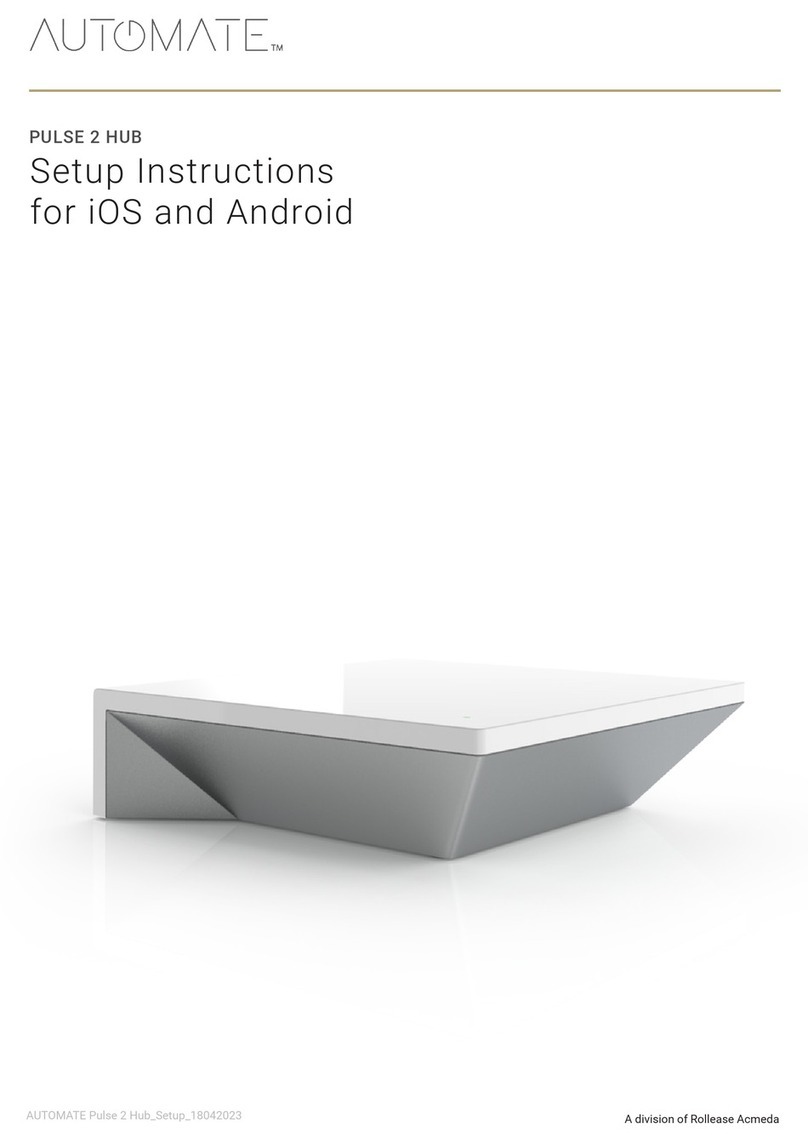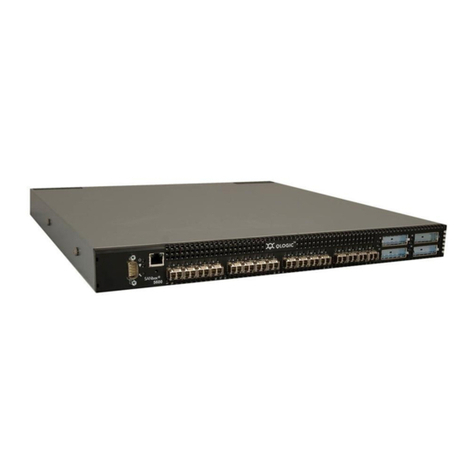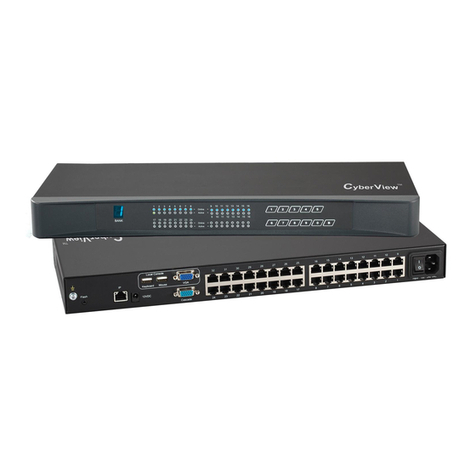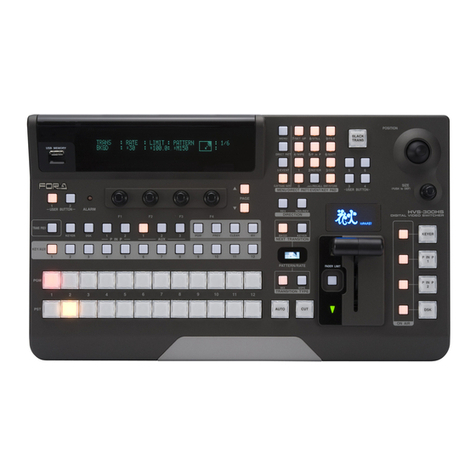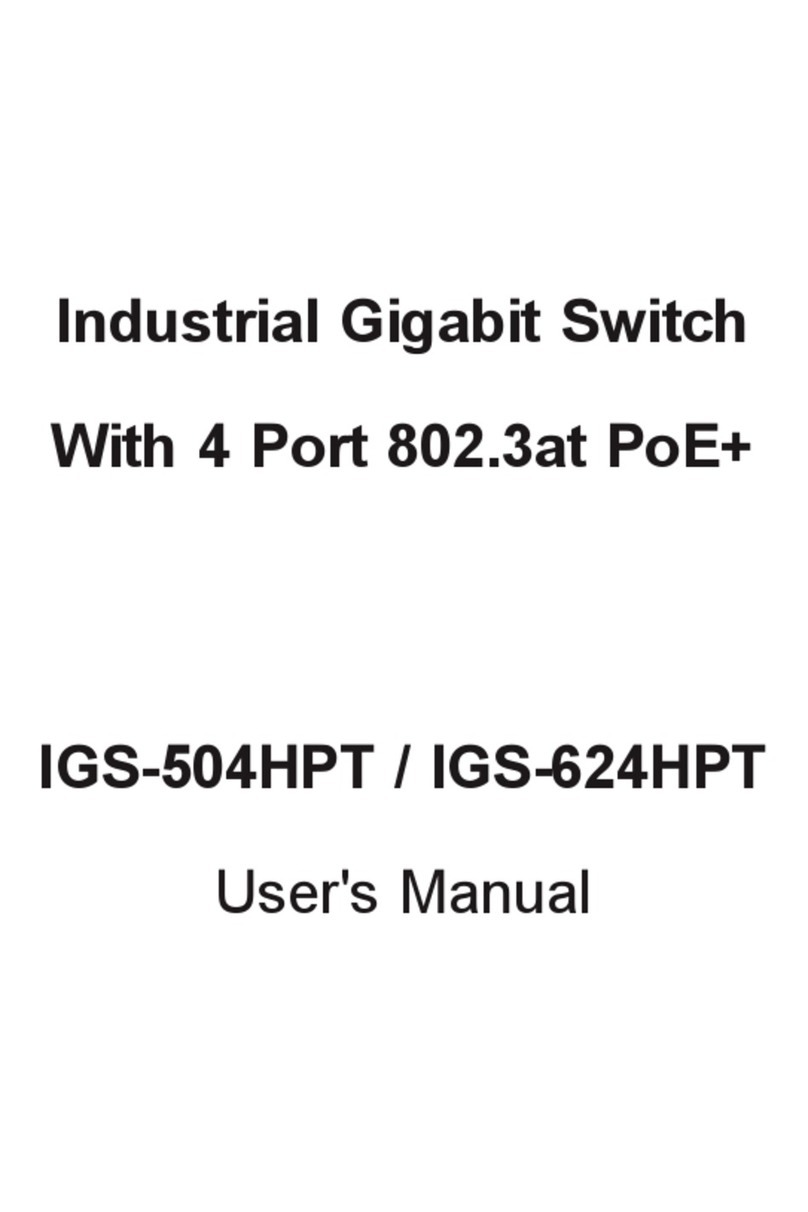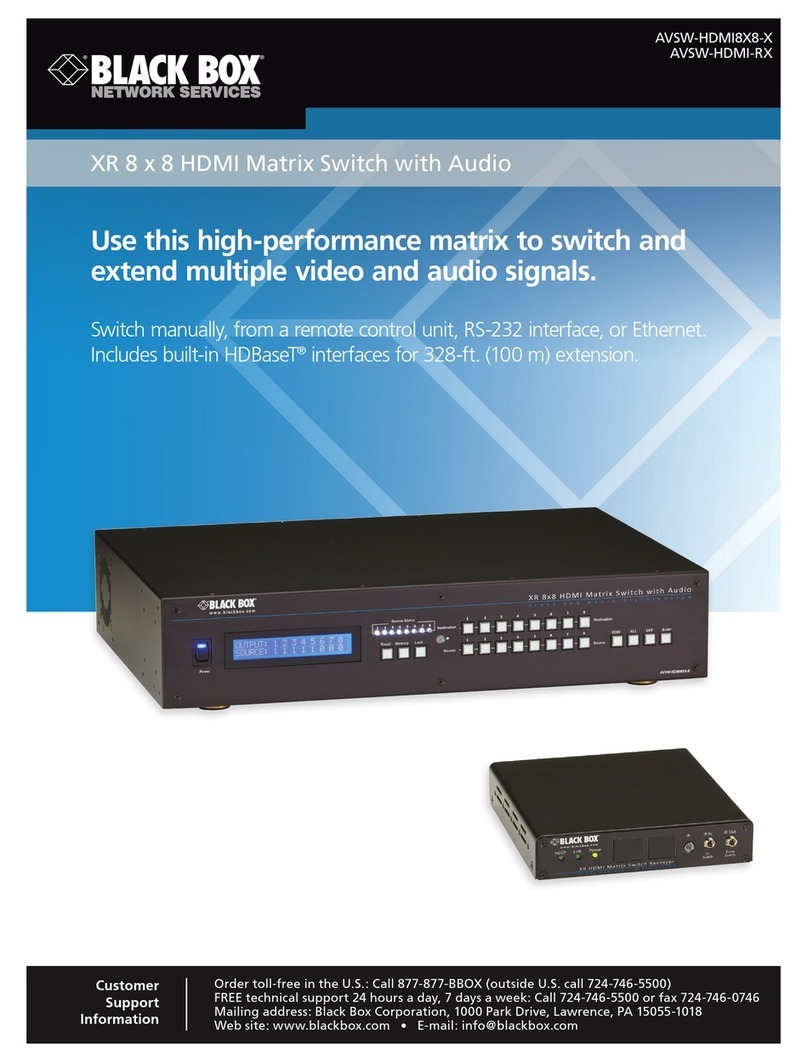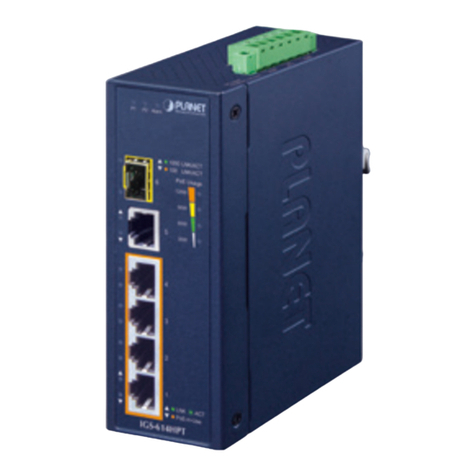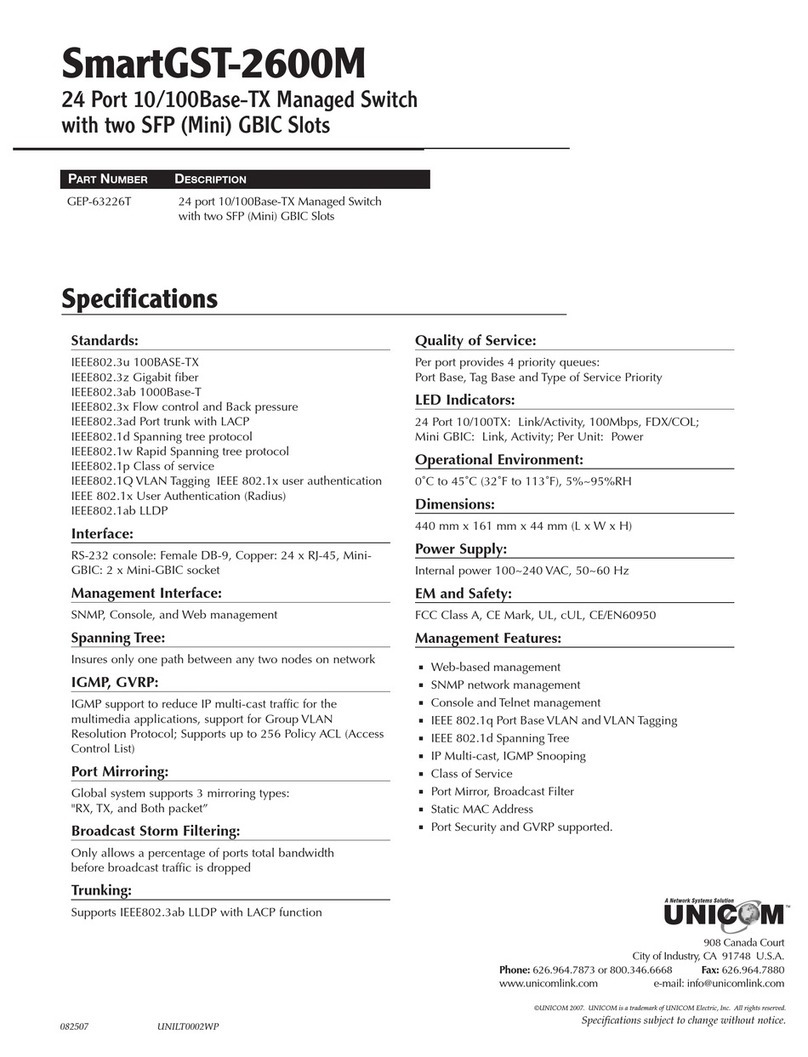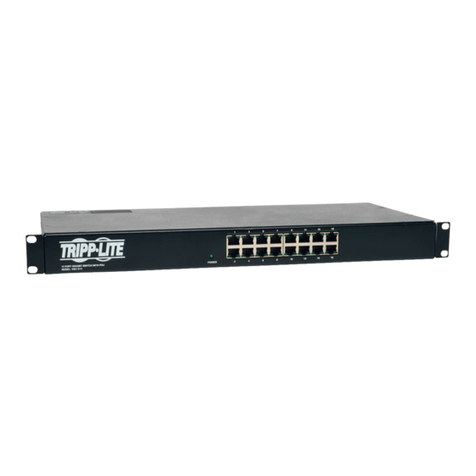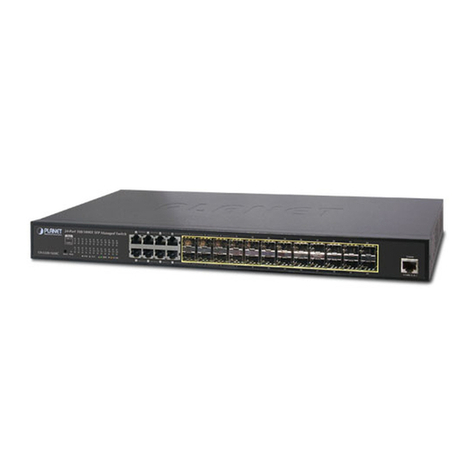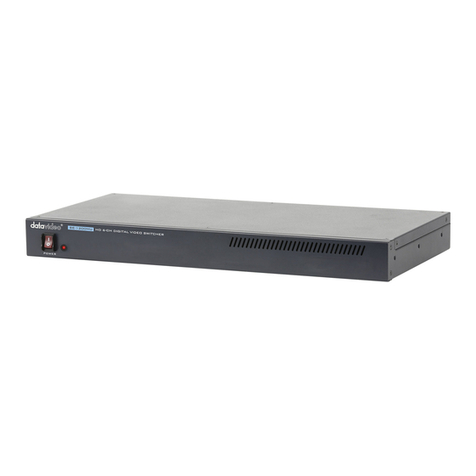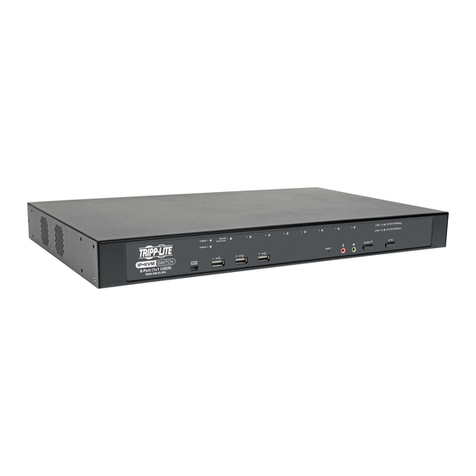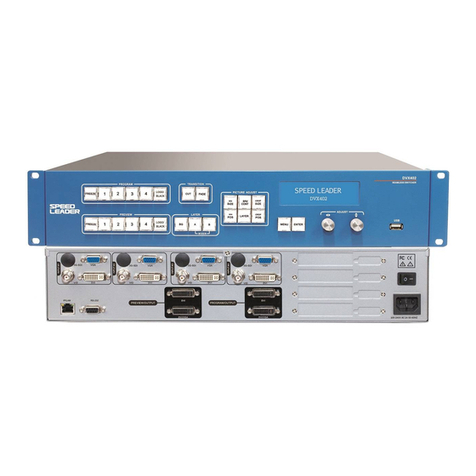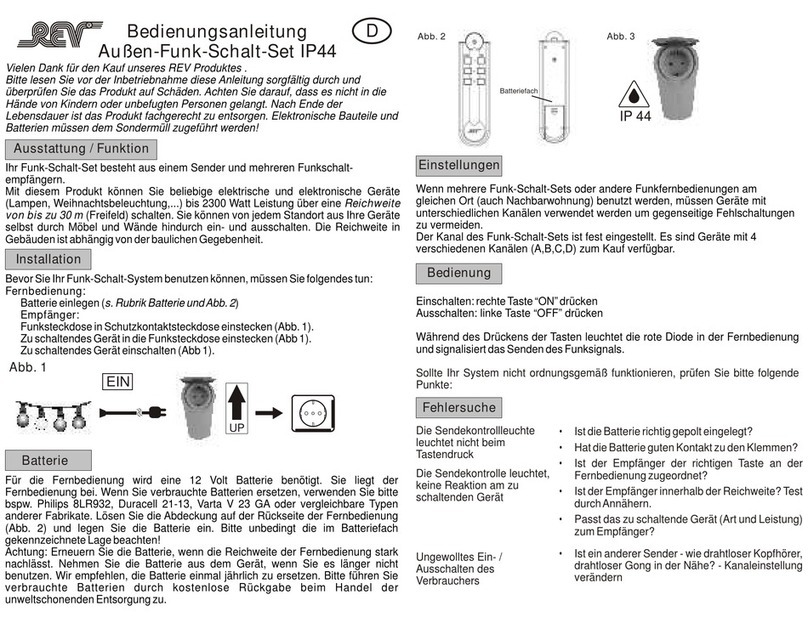digitalSTROM P44-DSB-D User manual

plan44.ch digitalSTROM-Bridge für DALI und hue
Funktion und Verwendungszweck
Die P44-DSB-D digitalSTROM-Bridge enthält ein DALI-Bus-Interface und ein
Embedded Linux Modul mit Ethernet. Die digitalSTROM-Funktionalität wird durch
die werkseitig installierte Firmware bereitgestellt.
Die P44-DSB-D digitalSTROM-Bridge dient zur Erweiterung eines digitalSTROM-
Systems durch bis zu 64 DALI-Leuchten (je 3 DALI-Kanäle können auch zu einer
RGB-Farblampe kombiniert werden), sowie Philips “hue” LED-Lampen über die
“hue” bridge. Die Anbindung an den digitalSTROM Server erfolgt über eine
Ethernet-Netzwerkverbindung.
Sicherheitshinweise
!
Lebensgefahr: Berühren der elektrischen Hausinstallation unter Spannung!
(230 V AC) kann zum Tod oder zu schwersten Verbrennungen führen.!
Vor der Installation dieses Gerätes prüfen, ob der DALI Bus korrekt verdrahtet
und vom Niederspannungsnetz isoliert ist.
!
Nur geschultes Fachpersonal darf das Gerät installieren und in Betrieb
nehmen. Landesspezifische Vorschriften sind einzuhalten.
!
Das Gerät darf nur in trockenen und geschlossenen Räumen betrieben und
nicht zu direkt oder indirekt gesundheits- oder lebenssichernden Zwecken
benutzt werden oder zu Zwecken, bei denen ein Ausfall des Gerätes zu
Gefahren für Menschen, Tiere oder Sachwerten führen kann.
!
Das Geräts ist vor Zugriff durch Unbefugte sowie vor Fremdkörpern, die durch
Lüftungsöffnungen eindringen könnten, geschützt zu installieren.
!
Das Gerät entwickelt im Betrieb Wärme. Bei der Installation ist darauf zu
achten, dass diese Wärme ausreichend über die Luftzirkulation abgegeben
werden kann und das Gerät nicht überhitzt.
Installation
!
Das Gerät enthält bereits die Stromversorgung für den DALI-Bus. Es darf
nicht mit DALI Netz- Bedien- oder Steuergeräten kombiniert werden, die
eine eigene Busversorgung beinhalten, andernfalls nimmt das Gerät
Schaden und muss ggf. ersetzt werden. Vor dem Anschluss des Geräts bitte
überprüfen, dass der DALI-Bus spannungslos ist!
1. Gerät an geeignetem Ort montieren.
2. Verbinden mit dem lokalen Netzwerk, an dem auch der digitalSTROM-Server
angeschlossen ist. Das Gerät bezieht seine IP-Konfiguration via DHCP. Für
Firmware-Updates muss das lokale Netzwerk auch Zugang zum Internet
bereitstellen - für den Betrieb ist kein Internet-Zugang erforderlich.
3. DALI Bus (vorher Isolation vom Niederspannungsnetz prüfen!) mit
mitgelieferter grüner Steckklemme mit dem Gerät verbinden.
4. Stromversorgung anschliessen (mitgeliefertes USB 5V-Netzteil oder über
Ethernet-Kabel mit separat erhältlichem Passiv-PoE-kit P44-DSB-PPoE).
5. Die Kontroll-LED leuchtet gelb, sobald die Stromversorgung anliegt.
6. Sobald das Gerät voll betriebsbereit ist, leuchtet die LED grün, mit
gelegentlichem kurzen gelben Aufblitzen bei Aktivität.
!
Stromversorgung darf nie gleichzeitig über PPoE und USB-Netzteil erfolgen -
das Netzteil oder das P44-DSB-Gerät könnte dabei Schaden nehmen.
Verbindung mit dem digitalSTROM-System
Die Verbindung zum digitalSTROM-System erfolgt automatisch. Der digitalSTROM-
Server (Version 1.9 oder neuer) und die P44-DSB-D müssen dazu lediglich mit dem
gleichen lokalen IP-Netzwerk verbunden sein.
!
Verwenden Sie vorzugsweise einen gewöhnlichen Ethernetswitch zur
Verbindung von dSS und P44-DSB-D, und nicht direkt die Ports von Routern,
die der Internetprovider zur Verfügung stellt, denn diese unterbinden leider oft
Teile des Netzwerkverkehrs (IP multicast), so dass keine Verbindung zustande
kommt.
Im Webinterface kann der Netztwerk-Administrator bei Bedarf auch feste Werte für
IP-Adresse/Gateway/DNS konfigurieren.
Bedienung
Sobald das Gerät vom digitalSTROM-System
erkannt wurde, erscheinen im Web-
Konfigurator des digitalSTROM-Systems
(“Erweiterte Ansicht”, “Hardware”-Tab, Liste der
“Meter”) pro Geräteklasse (DALI, hue) ein
Eintrag. Über das Kontextmenu kann das
Webinterface der P44-DSB-D aufgerufen
werden.
Zudem kann das Webinterface direkt über die
“Bonjour”-Lesezeichen in Bonjour-fähigen
Web-Browsern (Safari) erreicht werden.
!
Das Webinterface ist über ein Login vor
unbefugtem Zugriff geschützt. Der
username ist “vdcadmin”, das Standard-
Passwort ist ebenfalls “vdcadmin”. Es ist
dringend empfohlen, das Passwort zu
ändern (im Abschnitt “System” des P44-DSB-
D Webinterface).
Aktualisierung der Firmware
Um sicherzustellen, dass das Gerät über aktuelle Firmware verfügt, sollte nach der
Inbetriebnahme eine Firmware-Aktualisierung vorgenommen werden:
1. Gerät muss betriebsbereit sein und via lokales Netzwerk mit DHCP Zugang
zum Internet haben.
2. Im Webinterface im Abschnitt "System" den Knopf "Check for new Firmware
Version…" drücken.
3. Wenn eine neue Firmware-Version verfügbar ist, wird sie angezeigt und kann
auf Knopfdruck geladen und installiert werden. Das dauert einige Minuten, bei
sehr langsamer Internet-Anbindung u.U. länger.
4. Die LED am Gerät blinkt gelb/rot während des ganzen Firmware-Upgrades.
!
Ein Firmware-Update kann auch ohne Web-Interface mit dem Taster im Gerät
(kleines Loch rechts neben der Status-LED an der Gehäuseseite, mit
Kugelschreiber vorsichtig bedienen) ausgelöst werden: Taster drücken und ca
6 Sek. halten, bis LED rot leuchtet, dann loslassen.
!
Auf keinen Fall die Stromversorgung während des Aktualisierungs-
Prozesses trennen! Andernfalls kann die Systemsoftware beschädigt werden
und das Gerät muss ersetzt werden. Allfällige Unterbrüche der Internet-
Verbindung hingegen sind ungefährlich und führen lediglich dazu, dass die
Aktualisierung wiederholt werden muss.
DALI-Geräte hinzufügen oder entfernen
!
Für einen stabilen Betrieb sind 100% DALI-konforme Betriebsgeräte
empfohlen, die eine eindeutige Seriennummer haben. Leider gibt es auch
von namhaften Herstellern Geräte, die keine eindeutige Kennung haben und
damit anfällig sind, beim Änderungen am DALI-Bus vertauscht im System zu
erscheinen.
Die P44-DSB-D erkennt und konfiguriert DALI-Betriebsgeräte (Leuchtstoffröhren-
Vorschaltgeräte, LED-Dimmer) beim Aufstarten automatisch. Wurden die
Betriebsgeräte bereits von einem anderen DALI-Steuergerät konfiguriert, werden
bestehende Kurzadressen (interne Numerierung der DALI-Geräte) übernommen.
Bei fabrikneuen Betriebsgeräten ohne Numerierung oder bei sich überschneidener
Numerierung nimmt die P44-DSB-D automatisch eine Numerierung vor.
!
Wenn die P44-DSB-D die Kurzadressen wegen Überschneidungen
umprogrammieren muss, können sich dSUIDs der DALI-Geräte ändern.
Deshalb bitte nach Hinzufügen neuer Geräte, insbesondere wenn nicht
fabrikneu, Identifikation von Leuchten im digitalSTROM Konfigurator
überprüfen.
!
DALI-Betriebsgeräte sollten nicht im laufenden Betrieb hinzugefügt oder
entfernt werden. Bitte Stromversorgung der P44-DSB-D und aller DALI
Betriebsgeräte trennen, bevor am DALI-Bus Änderungen vorgenommen
werden.
!
Verwenden Sie die “DALI bus diagnostics...”-Funktion (“i”-Knopf in der DALI-
Titelzeile in der Geräteliste) für die Fehlersuche bei DALI-Bus-Problemen.
DALI Gruppen und RGB(W)-Lampen
Die P44-DSB-D kann DALI-Dimmergeräte in Gruppen (mehrere gleichgeschaltete
Leuchten) oder als Mehrkanal-RGB(W)-Farblampe ins digitalSTROM-System
einbinden.
1. Webinterface aufrufen, Abschnitt “Devices”
2. In der Geräteliste auf der Zeile “DALI vdc” den Knopf “+Group” drücken.
3. Im erscheinenden Dialogfeld die Art der Gruppe (Farblampe oder
Dimmergruppe) und die zu verwendenden Dimmer auswählen.
4. Taste “Create … device” drücken.In der Geräteliste erscheint eine (Farb)lampe
anstelle der Einzeldimmer, ebenso im digitalSTROM Konfigurator.
Das kombinierte Gerät kann auch wieder in unabhängige Dimmer aufgelöst werden:
“i”-Knopf drücken, und im erscheinenden Dialog den “Ungroup”-Knopf betätigen.
Hue-Bridge hinzufügen:
1. Im Webinterface im Abschnitt "Devices" den Knopf "Device Learn in/out…"
drücken.
2. Innert 20 Sek. die Taste an der hue-Bridge drücken.
3. Es erscheint eine Quittierungsmeldung, wenn die hue-Bridge eingelernt oder
ausgelernt wurde.
!
Erscheint keine Quittierung bzw. eine Timeout-Meldung, dann besteht keine
Netzwerkverbindung zur hue-Bridge. Die hue Bridge sollte über einen nicht-
managed Switch zusammen mit der P44-DSB-D (und dem dSS) verbunden
sein. Managed Switches oder Router unterdrücken ggf. IPv4 Multicast, was für
den Verbindungsaufbau notwendig ist.
Auf der plan44 Website finden Sie die jeweils aktuelle Liste der unterstützten
Komponenten. Informationen zu weiterführenden Programmiermöglichkeiten finden
Sie auf https://plan44.ch/p44-techdocs/de. Unter https://forum.plan44.ch gibt es ein
User-Forum.
Gewährleistung
plan44.ch gewährt auf dieses Produkt eine mängelfreie Funktionalität gemäss
Spezifikation während einer Frist von 24 Monaten ab Lieferung durch plan44.ch.
Durch Öffnen des Gerätes, sonstige Geräteeingriffe oder unkorrekte Installation/
Konfiguration erlischt die Gewährleistung.
Technische Daten
Bezeichnung: P44-DSB-D
GTIN: 7640161170148
Hersteller: plan44.ch, CH-8048 Zürich, plan44.ch/automation
Masse: 138mm * 62mm * 31mm
Gewicht: ca. 120g
Betriebstemperatur: 0..+50 °C, nur in trockenen/geschlossenen Räumen
Netzwerk: 10/100 MBit/s Ethernet (RJ45 8P8C)
Stromversorgung: Externes Netzteil, USB, 5V/1A oder PPoE 12-24V
Stromverbrauch: typ. 260mA @ 5V (1.3W)
Vorschriften: EMC 2014/30/EU, RoHS 2011/65/EU,!
REACH (EC) No 1907/2006
Konformitätserklärung: plan44.ch/downloads/P44-DSB-D_DoC.pdf
Technische Änderungen vorbehalten. Aktuelle Informationen s. website plan44.ch
plan44.ch digitalSTROM-Bridge for DALI and hue
Function and intended use
The P44-DSB-D digitalSTROM bridge contains a DALI bus interface and an
embedded Linux module with Ethernet. The digitalSTROM functionality is provided
by the factory installed firmware.
The P44-DSB-D digitalSTROM bridge extends a digitalSTROM system by up to 64
DALI lights (3 DALI channels each can be combined to form a RGB color light) as
well as Philips “hue” LED lights via the “hue” bridge. The P44-DSB-D is connected
to the digitalSTROM server via an Ethernet network link.
Deutsch
English
plan44.ch
P44-DSB-D

Safety instructions
!
Warning: High voltage: Contacting or touching the electrical wires (230V AC)
may cause electrical shock and injury. Before installing the device, test that
DALI bus is correctly wired and isolated from 230V AC.
!
Only trained experts are authorised to install and commission the device.
Country-specific regulations must be adhered to.
!
The device may only be operated in dry, closed rooms and must not be used
directly or indirectly for health or life-saving purposes or for purposes where a
device failure could lead to danger for people, animals or material property.
!
The device is to be mounted such that it is protected from access by
unauthorized persons as well as from dust and debris entering the venitilation
slots.
!
The device produces heat. The device must be installed in a way such that
there is sufficient air circulation to dissipate the heat to the environment and
keep the device from overheating.
Installation
!
The device already contains a power supply for the DALI bus. It must not be
combined with DALI control devices having their own bus power supply,
otherwise, the device will get damaged and may need to be replaced. Before
connecting the device, please check that there is no voltage on the DALI
bus!
1. Mount the device at a suitable location.
2. Connect the device to the same local network where the digitalSTROM server
is also connected to. The device receives the IP configuration via DHCP. To
install firmware updates, the local network must also provide access to the
internet - for normal operation of the device however internet access is not
required.
3. Connect the DALI Bus (test isolation from 230V AC beforehand!) to the
device using the green screw terminal included.
4. Connect power (5V USB DC power supply included, or via ethernet cable with
separately sold Passive-PoE kit P44-DSB-PPoE).
5. The indicator LED lights up in yellow when power is applied.
6. As soon as the device is fully ready for operation, the LED turns green, with
only occasional short yellow flashes indicating activity.
!
Power must never by supplied by PPoE and USB at the same time - power
supply and P44-DSB device might get damaged when doing so.
Connection to the digitalSTROM System
The connection to the digitalSTROM-System is automatic. The digitalSTROM server
(Version 1.9 or newer) and the P44-DSB-D only need to be connected to the same
local IP network.
!
Preferably, use a regular Ethernet switch to connect dSS and P44-DSB-D, but
not just the ports of internet service provider's routers, as unfortunately, those
often block part of the network traffic (IP multicast) causing dSS connection to
fail.
Using the web interface, a network expert may set static IP/gateway/DNS
configuration when required.
User interface
As soon as the device has been recognized by the
digitalSTROM system, the digitalSTROM web
configurator (“Advanced View”, “Hardware” tab,
List of “Meters”) will show an entry per device class
(DALI, hue). Via the context menu the web interface
of the P44-DSB-D can be opened in a new browser
window/tab.
In addition, the P44-DSB-D web interface can be
reached directly from the “Bonjour” bookbark menu
in Bonjour enabled web browsers (Safari).
!
The web interface is proteced from
unauthorized access by a login. The user
name is “vdcadmin”, and the default password
is also “vdcadmin”. It is strongly
recommended to change the password (on
the “System” tab in the P44-DSB-D web interface).
Updating the Firmware
To make sure the device has up-to-date firmware, it is recommended to perform a
firmware upgrade as a first step:
1. Device needs to be powered and ready for use, and needs to have access to
the internet via local network with DHCP.
2. In the web interface in the "System" tab, click the "Check for new Firmware
Version…" button.
3. If new firmware is available, it will be downloaded and installed. This takes
approximately 5 minutes, possibly longer with very slow internet connection.
4. During the entire firmware upgrade process, the LED is flashing red/yellow.
!
Firmware update can also be triggered without web interface by using the
device button (small hole to the right of the status LED, use ball-pen to
carefully operate it): press and hold button for about 6 sec. until the LED turns
red, then release.
!
Do not disconnect power during firmware update! Otherwise, the system
software might get damaged and the device needs to be replaced. Interrupts in
the internet connection however are not critical but may just abort the update
process and require that the update is started again.
Adding or removing DALI devices
!
For stable operation, 100% DALI conformant ballast devices are
recommended, as these do have a unique serial number. Unfortunately,
there are devices even from well-known companies which do not have a
unique serial number, and thus are susceptible to be shown swapped with
other devices after changes in the DALI bus.
The P44-DSB-D detects and configures DALI ballast devices (fluorescent tube
drivers, LED dimmers) automatically at startup. If the DALI ballast devices have
been configured already by another DALI control device, existing DALI short
addresses will be re-used. For brand new DALI devices without short address or in
case of numbering conflicts, the P44-DSB-D automatically assigns short addresses.
!
If the P44-DSB-D needs to reconfigure short addresses due to conflicts, the
dSUIDs of the DALI devices might change. Therefore, after adding new
devices, in particular not brand new ones, please re-check identification of
lights in the digitalSTROM Configurator.
!
DALI devices should not be added or removed from the bus in operation.
Please disconnect power from the P44-DSB-D and all DALI devices before
making changes to the bus.
!
Use the “DALI bus diagnostics...” feature (“i”-button in the DALI header row of
the device list) to diagnose DALI bus problems.
DALI Groups and RGB(W)-Lights
The P44-DSB-D can combine DALI dimmers as a group (multiple synchronized
lights) or a multi-channel RGB(W) color light into the digitalSTROM-System.
1. Open the web interface, “Devices” tab
2. In the list of devices, on the “DALI vdc” row, press the “+Group” button.
3. In the dialog, select the type of group (color light or dimmer group) and the
DALI dimmers to be included
4. Press “Create … device” button.
5. In the list of devices, a single (color) light device replaces the separate
dimmers, the same happens in the digitalSTROM Konfigurator.
The combined device can be separated into individual dimmers later: press the “i”
button, then press “Ungroup” button in the dialog.
Adding a hue bridge
1. In the webinterface, in the "Devices" tab, press the "Device Learn in/out…"
button.
2. Within 20 seconds, press the center button of the hue bridge.
3. A confirmation alert appears when the hue bridge has been learned in or out.
!
If no acknowledgement or a timeout message appears, then there is no
network connection to the hue bridge. The hue bridge should be connected
via a non-managed switch together with the P44-DSB-D (and the dSS).
Managed switches or routers may suppress IPv4 multicast, which is
necessary to establish a connection.
The plan44.ch website provides a list of all supported components. Information on
advanced programming options can be found at https://plan44.ch/p44-techdocs/en.
There is a user forum at https://forum.plan44.ch.
Guarantee
plan44.ch guarantees fault-free operation of this device according to the
specification for 24 months after delivery by plan44.ch. Opening the device, other
interference with the device, or incorrect installation/configuration will invalidate the
guarantee.
Technical data
Name: P44-DSB-D
GTIN: 7640161170148
Manufacturer: plan44.ch, CH-8048 Zürich, plan44.ch/automation
Dimensions: 138mm * 62mm * 31mm
Weight: approx. 120g
Operating temp.: 0..+50 °C, indoor use in dry/closed rooms only
Network: 10/100 MBit/s Ethernet (RJ45 8P8C)
Power supply: External power supply, USB, 5V/1A or PPoE 12-24V
Power consumption: typ. 260mA @ 5V (1.3W)
Regulations: EMC 2014/30/EU, RoHS 2011/65/EU,!
REACH (EC) No 1907/2006
Declaration of Conformity: plan44.ch/downloads/P44-DSB-D_DoC.pdf
Subject to technical modifications. Up-to-date information available at plan44.ch
plan44.ch digitalSTROM bridge pour DALI, hue
Instructions de sécurité
!
Danger de mort! Tout contact avec une installation intérieure électrique sous
tension (230 V AC) peut entraîner des blessures graves, voire même la mort.
Avant d'installer cet appareil, vérifier que le bus DALI est correctement câblé et
isolé de 230V AC.
!
Seuls des spécialistes formés sont autorisés à installer cet appareil et à le
mettre en service. Respecter les directives nationales en vigueur.
!
L‘appareil ne doit être utilisé que dans des locaux secs et fermés et non à des
fins (directement ou indirectement) à risque pour la santé ou pouvant entraîner
la mort, ni à des fins pour lesquelles une panne de l‘appareil peut présenter un
danger pour les personnes, les animaux ou les biens matériels.
!
L'appareil doit être installé de manière qu'il soit protégé contre les accès par
des personnes non autorisées de même que de la poussière et de débris
d'entrer dans les fentes de venitilation.
!
L'appareil produit de la chaleur. L'appareil doit être installé de manière à
permettre une circulation d'air suffisante pour dissiper la chaleur a
l'environnement pour eviter la surchauffe de l'appareil.
plan44.ch digitalSTROM bridge per DALI, hue
Avviso di sicurezza
!
Pericolo di morte! Toccare un impianto elettrico interno sotto tensione (230 V
AC) può causare la morte o ustioni gravi. Prima di installare questo dispositivo,
controllare che il bus DALI sia correttamente cablata e isolato da 230V AC.
!
Il dispositivo deve essere installato e messo in funzione solo da personale
tecnico specializzato e appositamente formato. Osservare le direttive
specifiche vigenti a livello nazionale.
!
il dispositivo deve essere attivato solo in ambienti chiusi e asciutti e non deve
essere utilizzato né direttamente né indirettamente per la protezione della vita
o della salute o per qualsiasi altra finalità per cui un guasto del dispositivo
stesso possa determinare un pericolo per persone, animali o beni materiali.
!
Il dispositivo deve essere installato protetto dall'accesso di persone non
autorizzate e contro corpi estranei che possono entrare attraverso le aperture
di ventilazione.
!
Il dispositivo produce calore. Il dispositivo deve essere installato in modo tale
che vi sia sufficiente circolazione d'aria per dissipare il calore all'ambiente per
evitare il surriscaldamento del dispositivo.
Français
Italiano
P44-DSB-D-manual, 2022-01-12 © 2017-2022 plan44.ch
Table of contents
Languages:
